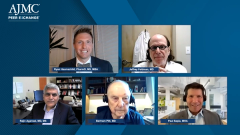
Screening for CKD
Dr Rajiv Agarwal explains the screening process for patients with CKD, including those who are asymptomatic.
Episodes in this series

Ryan Haumschild, PharmD, MS, MBA: Let’s talk about the management of CKD [chronic kidney disease] and cardiovascular [CV] disease and risk. Let’s discuss the treatment and management landscape of chronic kidney disease and explore the relationship between that and cardiovascular risk, building on the great points that Dr Pitt gave. Hopefully we can identify potential areas of opportunity for the use of novel agents in classes such as SGLT2s and mineralocorticoid receptor antagonists in chronic kidney disease and cardiovascular disease. To start, I’m going to pivot to Dr Agarwal. What’s the early detection of chronic kidney disease? How is it important for early intervention and the slowing of disease progression? How are patients screened for CKD in the current state, in particular those who are asymptomatic?
Rajiv Agarwal, MD, MS: We have a pretty smooth state now. Most people are screened for CKD using eGFR [estimated glomerular filtration rate] or serum creatinine–based measurements. That identifies a stage of kidney failure, not an early stage of kidney disease. Because if you look at the enhanced database and look at the proportion of people in the United States who have early CKD, which means stage 1 or stage 2 CKD, it far outnumbers stages 3, 4, and 5 combined, so we aren’t picking them up. Why? Because we aren’t checking their urine.
In the past, we thought, “We need to give the patient a jug, and they have to collect a 24-hour urine.” That’s no longer true. The ideal situation is to give them a cup and ask them to pee into that cup the first time they urinate in the morning. That’s the urine they give to the office, and you check it for albumin and creatinine, what we call a UACR [urine albumin-to-creatinine ratio]. If it’s more than 30 mg/g, that’s albuminuria. That’s a point of intervention, especially if you have type 2 diabetes. If you have more than 300 mg/g creatinine, that’s macroalbuminuria, or what we call very high albuminuria. Most people would investigate and treat that condition, and perhaps refer the patient to a nephrologist.
The early diagnosis of CKD relies on screening for albuminuria in the first morning void. If the patient forgets and says, “I forgot my cup,” what do I do? They can get a cup and urinate in the cup, and that can be sent from the office. Now you need at least 2 measurements above the threshold. Of course, if somebody has 2 mg/g of albuminuria, you don’t need a second cup. But if you’re around 30 mg/g, you say, “Let me confirm that you have albuminuria before I start treating you.” That becomes important.
We aren’t doing a good job of screening for albuminuria. Nationally, it’s about 15% screening rates. In good practices, maybe it gets to 30%. Nationally, there are some places that can get to 60%, but nobody is at the 80% or 90% mark. We aren’t doing a good job of screening these patients early. The reason this is important is that in the past, we didn’t have much, as Jeff pointed out. We had only ACE [inhibitors], ARBs, and diuretics, and we were more focused on the kidney-specific outcomes in people with kidney disease. Now we’re learning that kidney disease is a cardiovascular disease. It’s the rare and lucky few who progress onto dialysis. Many will have cardiovascular death, develop heart failure, or have myocardial infarction or strokes. Most may have CV death or be hospitalized for heart failure. In those individuals, prevention is the key.
We’ll talk about the therapies in a short time, but it’s no longer an academic interest. In fact, it has been put on the HEDIS [Healthcare Effectiveness Data and Information Set] measure as a quality metric. Your payment may be held back if you don’t start doing UACR on a more frequent basis on a patient, especially with type 2 diabetes.
Ryan Haumschild, PharmD, MS, MBA: Great overview. Early detection and using eGFR and UACR are important. I appreciate you going through that with us, and the importance of recognizing these patients and the connections between cardiovascular risk and CKD.
Transcript edited for clarity.
Newsletter
Stay ahead of policy, cost, and value—subscribe to AJMC for expert insights at the intersection of clinical care and health economics.






























































